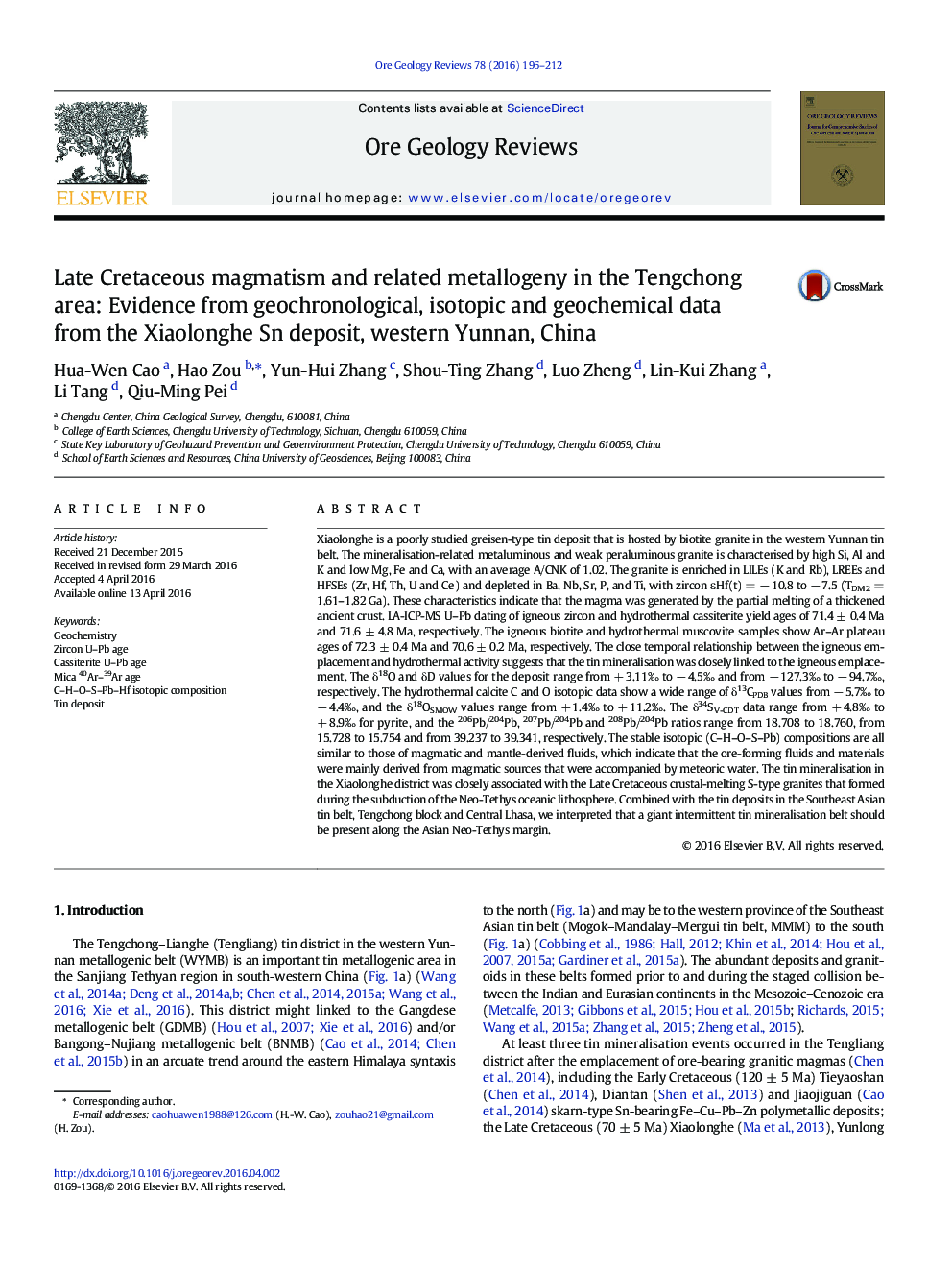| کد مقاله | کد نشریه | سال انتشار | مقاله انگلیسی | نسخه تمام متن |
|---|---|---|---|---|
| 4696848 | 1637228 | 2016 | 17 صفحه PDF | دانلود رایگان |

• A detailed ore geology and geochemistry of the Xiaolonghe Sn deposit has been presented.
• It is first time to date Xiaolonghe deposit using different minerals and measures.
• Large-scale Sn mineralization event occurred during the Late Cretaceous (70–72 Ma).
• C–H–O–S–Pb isotopes suggest magmatic source.
• There is a giant intermittent tin belt along the Asian margin of Neo-Tethys.
Xiaolonghe is a poorly studied greisen-type tin deposit that is hosted by biotite granite in the western Yunnan tin belt. The mineralisation-related metaluminous and weak peraluminous granite is characterised by high Si, Al and K and low Mg, Fe and Ca, with an average A/CNK of 1.02. The granite is enriched in LILEs (K and Rb), LREEs and HFSEs (Zr, Hf, Th, U and Ce) and depleted in Ba, Nb, Sr, P, and Ti, with zircon εHf(t) = − 10.8 to − 7.5 (TDM2 = 1.61–1.82 Ga). These characteristics indicate that the magma was generated by the partial melting of a thickened ancient crust. LA-ICP-MS U–Pb dating of igneous zircon and hydrothermal cassiterite yield ages of 71.4 ± 0.4 Ma and 71.6 ± 4.8 Ma, respectively. The igneous biotite and hydrothermal muscovite samples show Ar–Ar plateau ages of 72.3 ± 0.4 Ma and 70.6 ± 0.2 Ma, respectively. The close temporal relationship between the igneous emplacement and hydrothermal activity suggests that the tin mineralisation was closely linked to the igneous emplacement. The δ18O and δD values for the deposit range from + 3.11‰ to − 4.5‰ and from − 127.3‰ to − 94.7‰, respectively. The hydrothermal calcite C and O isotopic data show a wide range of δ13CPDB values from − 5.7‰ to − 4.4‰, and the δ18OSMOW values range from + 1.4‰ to + 11.2‰. The δ34SV-CDT data range from + 4.8‰ to + 8.9‰ for pyrite, and the 206Pb/204Pb, 207Pb/204Pb and 208Pb/204Pb ratios range from 18.708 to 18.760, from 15.728 to 15.754 and from 39.237 to 39.341, respectively. The stable isotopic (C–H–O–S–Pb) compositions are all similar to those of magmatic and mantle-derived fluids, which indicate that the ore-forming fluids and materials were mainly derived from magmatic sources that were accompanied by meteoric water. The tin mineralisation in the Xiaolonghe district was closely associated with the Late Cretaceous crustal-melting S-type granites that formed during the subduction of the Neo-Tethys oceanic lithosphere. Combined with the tin deposits in the Southeast Asian tin belt, Tengchong block and Central Lhasa, we interpreted that a giant intermittent tin mineralisation belt should be present along the Asian Neo-Tethys margin.
Figure optionsDownload as PowerPoint slide
Journal: Ore Geology Reviews - Volume 78, October 2016, Pages 196–212